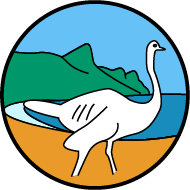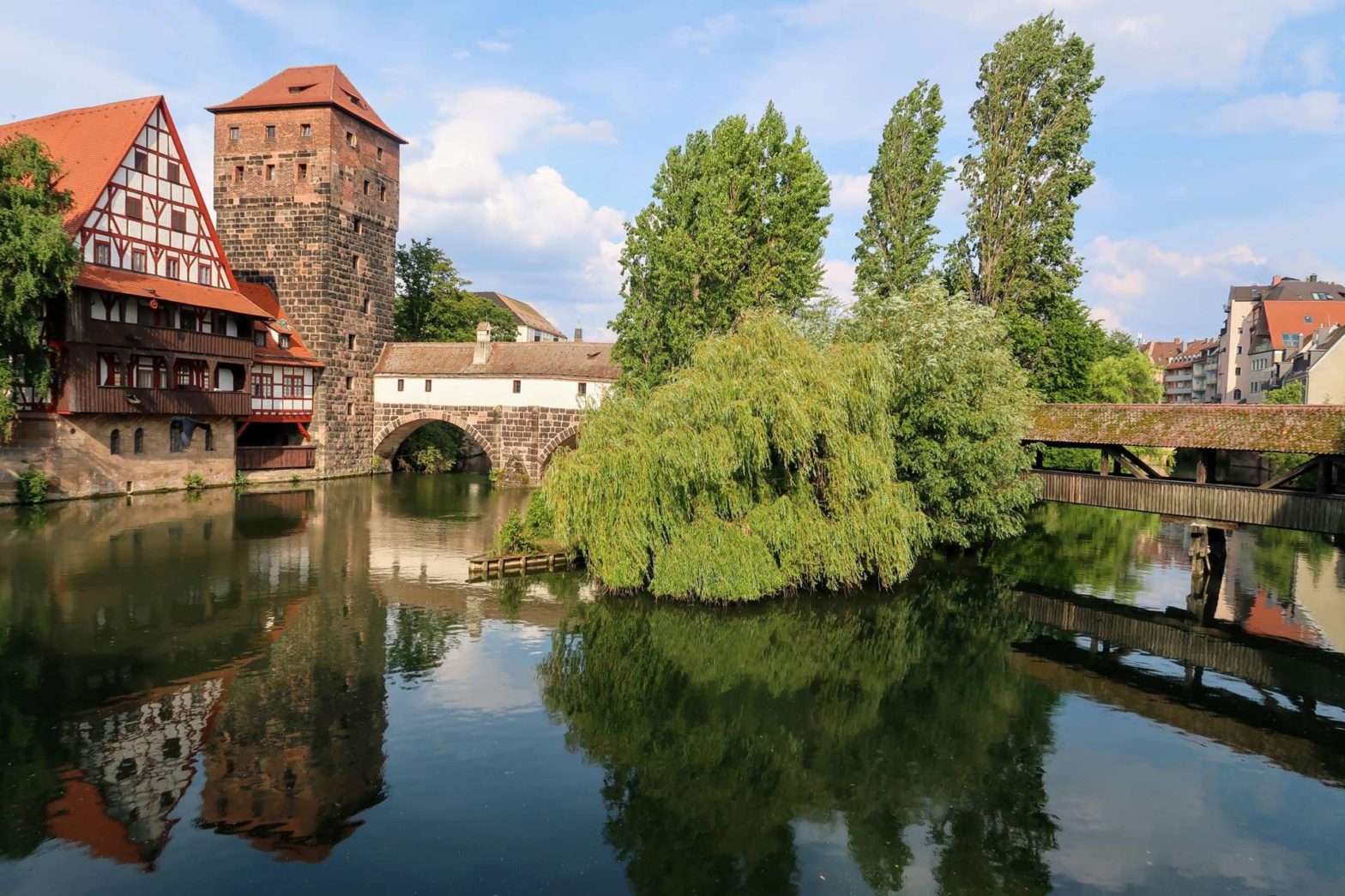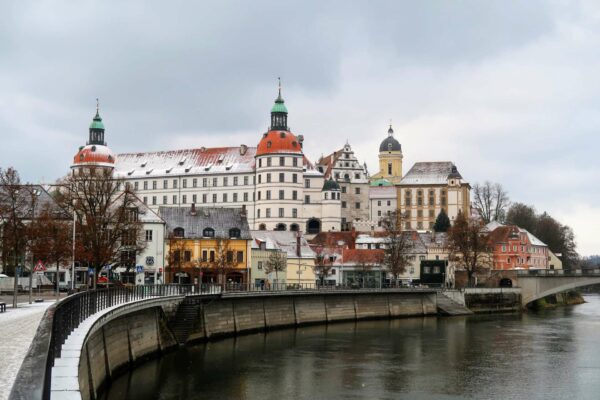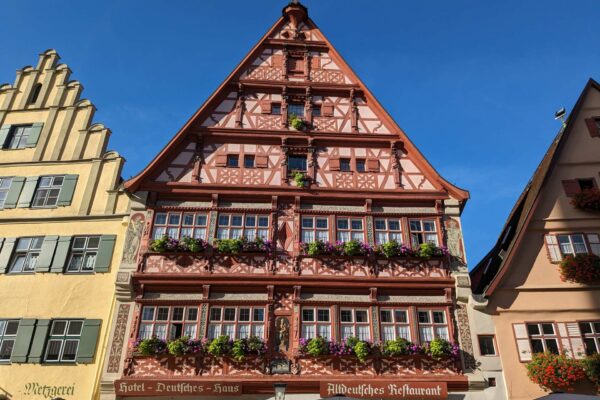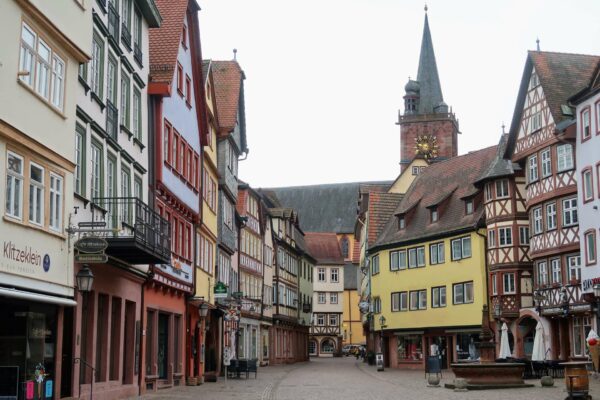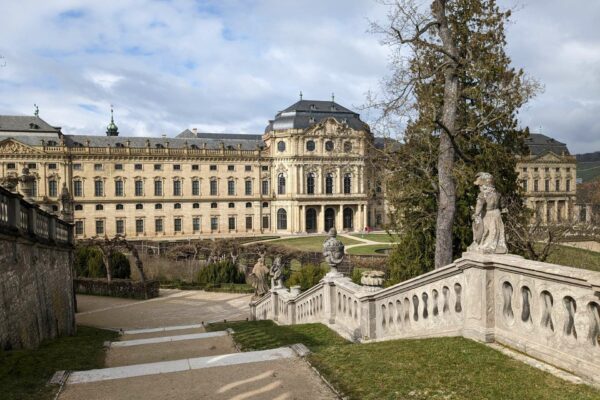By Vicky · Published Jul. 25th, 2022 · Updated Dec. 18th, 2023
When you buy through links highlighted with an asterisk (*) on this site, we may earn a small affiliate commission at no cost to you.
A Walking Tour of Nuremberg (Nürnberg) is the best way to explore this delightful historical city in Bavaria. Discover half-timbered houses, many museums, the famous Nuremberg Trials and the home of Albrecht Dürer. This is a free self-guided walking tour, but if you prefer, check out this great guided tour of Nuremberg*.
Page Contents:
Location
This walk starts from Nuremberg train station. It’s 1hr20-1hr50 minutes on the train from Augsburg and 1hr-2hrs from Munich. It’s slightly longer if you decide to drive.
Nuremberg Self-Guided Walking Tour Map
Get the route by downloading the .gpx or .kml file below. For navigation with Maps.me on your mobile phone, simply download the .kml file and open to add it to the Maps.me bookmarks.
Tips for Nuremberg Walking Tour
- The Nuremberg City Museums are €6 each, or 9 for a day pass that lets you visit all of them. These include: the Documentationzentrum, the Memorial Nuremberg Trials, Albrecht Dürer Haus, and the Stadtmuseum Fembohaus.
- There’s a famous Christmas market here (from late November to Christmas Eve).
- This walking tour lasts 2-5 hours depending on how long you spend in the museums.
- Why not also explore the cute town of Donauwörth, less than an hour away from Nuremberg on the train.
- Check out other walks on our Germany Hiking Page.
Top Sights in Nuremberg
On this self-guided walking tour you’ll see the main sites and attractions of Nuremberg. One to two days is the perfect amount of time to spend in Nuremberg.
- St Lorenz Church
- Hauptmarkt & Frauenkirche
- Altes Rathaus & Medieval Dungeons
- St Sebaldus Church
- Stadtmuseum Fembohaus
- Kaiserburg
- Tiergärtnertor Square
- Albrecht Dürer Haus
- Historischer Kunstbunker
- Felsengänge
- Pegnitz River Views
- Weisser Turm Square
- Germanisches Nationalmuseum
This walking tour of Nuremberg is self-guided and free. If you prefer to be accompanied, book a guided walking tour of Nuremberg*.
Nuremberg Walking Tour Route
This walking tour starts from Nuremberg train station. Then enter through a gate in the grand city walls, a 5 km defensive wall surrounding Nuremberg Old Town.
Directions: From the train station, cross over the large road towards the impressive city walls and walk through the gate.
The walls are a 5 km defensive structure from the 12th century which surrounds Nuremberg Old Town. Once through the city gate, you’ll be in the Handwerkerhof (Tripadvisor Reviews*). This is a replica of an old craft quarter, a bit of a tourist trap, but also rather cute. It’s at the foot of the Frauentorturm, the old tower at the corner of the city walls. You’ll find lots of little shops and Bavarian restaurants selling bratwurst and other German specialties.
Directions: Head out of the Handwekerhof in the opposite corner, by the tower, and head left along Königstraße, a wide pedestrianised street. This street will eventually lead you all the way to the Hauptmartk & Frauenkirche via some interesting buildings.
As you walk up the street, note the Former Customs House (Mauthalle), a large warehouse building from the Middle Ages.
Soon you’ll reach the square of St Lorenz Church. This square also contains many stalls selling food and drinks, from hotdogs to crepes and more.
1. St Lorenz Church
St Lorenz Church (Lorenzkirche) (Tripadvisor Reviews*) is an atmospheric Medieval church with soaring stone pillars and beautiful stained glass windows. It suffered significant damage during bombing in the Second World War but was fully restored. It’s free to visit, with a voluntary donation. Open 9am-5pm Mon-Sat, 1pm-3:30pm Sun.
After visiting the church, continue across Museum Bridge. Look to your right from the bridge and you’ll see the see Heilig-Geist-Spital. This is a former hospital, built partially over the river and dedicated to the Holy Spirit. Elderly people also found refuge in the Heilig-Geist-Spital, which was started in 1339. Today it contains a historic restaurant (Website, Tripadvisor Reviews*).
2. Hauptmarkt & Frauenkirche
On the other side of the river you’ll soon reach the Hauptmarkt (Tripadvisor Reviews*). This is the busy main square in Nuremberg Old Town. There’s a market here every day and the famous Christkindlesmarkt is here from November until Christmas Eve.
On one side of the square is the Frauenkirche (Tripadvisor Reviews*), a Gothic church dating to 1352-1362. It’s built on the site of a former Jewish synagogue which was destroyed during a program in 1349, after townspeople blamed the Jews for an outbreak of the Black Death.
At noon every day, the Männleinlaufen glockenspiel (a mechanical clock) puts on a display. Mechanised figures come out from just below the church clock, with princes dancing around the Holy Roman Emporer.
In the middle of the square is the Gothic Schoner Brunnen (Beautiful Fountain), a replica of a fountain from the 14th century. There is no water in it today, but it’s still very brightly coloured.
Directions: Continue uphill along the street that leaves the Hauptmarkt near the Schoner Brunnen.
3. Altes Rathaus & Medieval Dungeons
Key Information: Medieval Dungeons by tour only, every day on the hour from 11am to 3pm, tours last roughly 30 minutes. Tickets are €4.
The Altes Rathaus is a Renaissance building from 1616. Inside you can visit the Medieval Dungeons, or Mittelalterliche Lochgefängnisse (Website, Tripadvisor Reviews*). On the tour, you see a torture chamber and several prison cells, in a vaulted underground cellar. You’ll also learn about life in Medieval Nuremberg.
Directions: Opposite the Altes Rathaus is St Sebaldus Church. Head around the church to the entrance on the other side.
4. St Sebaldus Church
St Sebaldus Church (Tripadvisor Reviews*) is the oldest church in Nuremberg. It was built in the 13th century from pink sandstone. It’s free to enter and open 9:30-6pm every day. It has some beautiful stained glass windows, vaulted ceilings and tall stone pillars inside. It’s named after St Sebaldus, a hermit from the 8th century, now the patron saint of Nuremberg.
Directions: Head to the opposite side of the square by the church, and then left up a narrow street. At the T-junction turn right. There are several lovely old half-timbered houses along this street. At the main street, you’ll find the Stadtmuseum Fembohaus on the corner.
5. Stadtmuseum Fembohaus
Key Information: Open Tue-Sun, 10am-5pm (until 6pm weekends), closed Mondays. Tickets €6/1.50 for adults/concessions. Included in Nuremberg Municipal Museums Day Pass (€9).
The Stadtmuseum Fembohaus (Website, Tripadvisor Reviews*) occupies a former merchant’s house from the late 16th century. The highlight of the museum is the building that it’s in. The exhibits themselves are almost all in German and there didn’t seem to be a coherent story, only ad hoc displays of items. The best bit was finding a virtual reality headset showing a synagogue. If you have the Museums Day Pass, it’s worth walking around briefly to see the building.
Directions: Walk left up the street towards the castle. Continue slightly right and upwards before heading left to enter inside the castle walls.
6. Kaiserburg
Key Information: Open 9-18 (Apr-Sep), 10-16 (Oct-Mar). Tickets are €5.50/4.50 per adult/concession for the Kaiserburg Museum and Chapel. It’s €3/2 per adult/concession for the Deep Well and Sinwell Tower.
The Kaiserburg (Website, Tripadvisor Reviews*) is the Imperial Castle of Nuremberg – a large medieval castle complex at the top end of Nuremberg Old Town and one of the city’s top sights. Construction of the castle began in the 12th century and it was expanded for the next few hundred years. For much of this time it held the treasures of the Holy Roman Empire and was frequently visited by the Emporer himself.
Within Nuremberg Imperial Castle
Within the castle complex you can visit the Kaiserburg Museum (which includes the Twin Chapel), and separately the Sinwell Tower and Deep Well. There’s a nice restaurant in the castle, in the open courtyard area that you can see without a ticket. You can also visit the castle gardens on the far, top side of the castle.
The Kaiserburg Museum describes the history of the castle, the heyday of Nuremberg, and medieval defence techniques. You can also see the royal living quarters and the Romanesque Doppelkapelle (Twin Chapel), one of the oldest original sections remaining.
Climbing the many stairs up Sinwell Tower, dating from the 13th century, gives you panoramic views over Nuremberg. Inside there’s also a photo exhibition documenting the bombing of the castle in the Second World War. Nearby, the Deep Well has a well shaft descending 50 metres into solid rock. Inside the building, you can watch a live film of the well’s interior and learn about its history.
Directions: Leave the castle courtyard the way you came and turn left into the Castle Gardens. Continue along the wall around the corner. Soon you’ll reach some stairs that lead into a covered walkway on the walls. There are great views from here over Tiergärtnertor Square. Exit the walkway and continue downwards to exit the gardens. Turn left through the city wall gate and left again, back up to Tiergärtnertor Square.
History of Nuremberg
On this walking tour you can explore the history of Nuremberg. It was a central city in the Holy Roman Empire for hundreds of years, from 1300 until 1700. Albrecht Dürer, a famous German artist, lived here from 1471 to 1528 when the city flourished as a place for arts and crafts. The town declined after 1700 due to European wars, but later developed as an industrial centre.
The Nazis came in the early 20th century, holding many large rallies here at the Parade Grounds. It was bombed badly during the war, but the Old Town was mainly reconstructed. Nuremberg is also famously the site of the War Crimes Tribunal which took place here after the Second World War, when top Nazis were put on trial.
7. Tiergärtnertor Square
Tiergärtnertor Square is a beautiful square and the historic centre of Nuremberg. It sits just beneath the castle, and as such was a busy trading area when the court of the Holy Roman Empire resided there. Today there are many cafes and restaurants with pleasant outdoor seating in the square. It’s also surrounded by some historic buildings.
The tower the square is named after, Tiergärtnertor, is a tower in the city walls from the 16th century. On the edge of the square is Albrecht Dürer Haus, a museum in the house of the famous artist. On the other side is the Historischer Kunstbunker, and just down the street are the Felsengänge (underground cellars).
Albrecht Dürer Haus
Key Information: Open Tue-Sun, 10am – 5pm (until 6pm on weekends). Also open Mondays in Summer (July-Sept). Tickets €6/1.50 for adults/concessions. Included in Nuremberg Municipal Museums Day Pass (€9).
Albrecht Dürer is one of Germany’s most famous artists and he lived here in this Haus (Website, Tripadvisor Reviews*) for almost 20 years. It’s fun walking around the old house with creaky floorboards and low ceilings. There’s an audio guide that explains what the rooms might have been used for and talks about Dürer’s artistic works. In the annex, there’s a room full of copies of his work, the originals being spread out in museums across the world.
Historischer Kunstbunker (Historic Art Bunker)
The Historischer Kunstbunker (Website, Tripadvisor Reviews*) is where valuable artworks were stored in WWII. It’s in an old rock vault beneath the Kaiserburg, almost 25 metres underground. You can only visit on a tour – 2pm every day plus another tour at 11:30am on weekends. Tickets are €9.50 per adult. Even if it’s warm outside, it will be quite cold inside.
Felsengänge (Rock Cut Cellars)
The Felsengänge (Website, Tripadvisor Reviews*) are a warren of underground cellars from the 14th century used by a brewery. They were also used as an air raid shelter during WWII. To visit you have to join a tour – the guides are great and the tours are amusing and interesting. Tours last 60-70 minutes and tickets start from €12 for the Historic Rock-Cut Cellars Tour.
Directions: Leave Tiergärtnertor Square via the street by Albrecht Dürer Haus. Continue downwards and straight on down the steps. At the T-junction turn right and then take the street branching left.
You’ll now be walking down Weissgerbergasse (Tripadvisor Reviews*), a beautiful street in Nuremberg. There are several half-timbered, colourful buildings on either side as the road gently curves around the corner.
Directions: At the end of Weissgerbergasse, cross over the road and turn left. You’ll soon see the backside of the large Weinstadel warehouse, an old wine depot. Continue onwards and take the next right to cross the river.
8. Pegnitz River Views
From the first bridge, Karlsbrucke, you can see the covered bridge within the Henker Haus (Executioner’s House) Museum (Website, Tripadvisor Reviews*). It’s open Tue-Sun, noon-5pm and costs €3/1.50 for entry. The museum itself is very small, and the best views are from the outside.
Once on the little island in the middle of Pegnitz River, head right to walk over the free part of Henkersteg (Hangman’s Bridge) to the far side of the river. Once across this bridge, head right along the river to the next bridge, Maxbrücke, where there are more great views.
Directions: Head up the street at the end of Henkersteg and continue upwards along the small passageway. Once you reach a larger pedestrianised square area, head right towards the tower.
Discover Walking Tours of other Bavarian Cities
9. Weisser Turm Square
At the centre of Weisser Turm Square is the historic Weisser Turm, or White Tower. It’s made of bricks so more red than white, but it looks quite grand anyway. at the base of the tower is the Ehekarussell Brunnen – the Marriage Carousel Fountain. This is a sculpture showing married life interpreted in six different ways. None of them are great ways to interpret a marriage – they don’t tend to look happy.
Directions: Leave the square along Breite Gasse, a pedestrianised shopping street by the fountain. There are many shops here, but fewer historic buildings. Take the second street to the right, in about 300 metres. It’s a small alley and leads to a larger road. Head straight onwards, across the large road and straight on slightly to the left. The distinctive Germanisches Nationalmuseum is on your left.
10. Germanisches Nationalmuseum
Key Information: Open Tue-Sun 10am – 6pm, until 8:30pm on Wed, closed Mondays. Tickets €8/5 for adults/concessions. Audioguide are an extra €2.
The Germanisches Nationalmuseum (Website, Tripadvisor Reviews*) describes the history and culture of Germany from prehistoric times to the early 20th century. There are works by German painters, musical and scientific instruments, archaeological collections and more. Don’t miss the Way of Human Rights at the entrance – symbolic white pillars and an oak tree stating the Universal Declaration of Human Rights.
Directions: This is the last stop on the tour. From here you can return to the main station via the city wall gardens in 10 minutes. Alternatively, there are two other museums nearby if you want to explore further.
Deutsche Bahn Museum
Key Information: Open 9-17 Tue-Fri, 10-18 Sat/Sun, closed Monday. Tickets €7/4 per adult/concession.
Explore Germany’s railway network in this fun museum (Website, Tripadvisor Reviews*). There’s a huge model railway, run every hour by a special conductor, and some interactive exhibits great for kids.
There are two big halls of train carriages and engines. Here you can see some very old railway carriages (from as far back as 1835) and much more. A highlight is Ludwig II’s train, a rococo train carriage (similar to his rococo horse-drawn carriages), the ‘Versailles of the Rails’. The ‘Adler’, Germany’s most famous steam train, is also here. It was the first train to carry commercial passengers, built by Stephensons of Newcastle.
Neues Museum
Key Information: Open Tue-Sun, 10am – 6 pm (until 8pm on Thu), closed Mondays. Tickets €7/6 for adults/concessions.
The Neues Museum (Website, Tripadvisor Reviews*) displays contemporary art and design pieces. Even if you don’t go inside, the outside is impressive – a huge curved glass front that reflects the buildings opposite.
Further Afield in Nuremberg
This walking tour of Nuremberg focused on the easily walkable old town, within the city walls. However, to fully explore Nuremberg there are two important sights within easy reach via public transport. The Nazi Party Rally Grounds are where much of the Nazi propaganda photos came from and where Hitler gave many speeches before WWII. The Memorial Nuremberg Trials is about the war crime trials that took place here shortly after the war.
Nazi Party Rally Grounds
Key Information: Grounds open 24/7. Dokumentationszentrum Museum open 10am-6pm every day. Tickets €6/1.50 for adults/concessions. Included in Nuremberg Municipal Museums Day Pass (€9).
Directions: Take Tram 8 from the Central Station to the Doku-Zentrum Stop. The journey takes 15 minutes and the tram departs every 10 minutes. If you’re in Nuremberg Castle area, walk to Hallertor Tram Stop and take Tram 6.
The Nazi Party Rally Grounds lie 4km southeast of Nuremberg centre and cover a large area that now contains lakes, grassy areas and car parks. They were designed for propaganda purposes, so Hitler had a good background to give his speeches. You may recognise some places from famous photos of Hitler addressing rallies.
It’s best to start your visit by heading to the museum, the Dokumentationszentrum (Website, Tripadvisor Reviews*). Here you will find an overview of the Rally Grounds, including their history and construction. There are also details of the Nazi Party’s rise to power and the importance of Nuremberg to Hitler and the Party. This museum is adjacent to the Kongresshalle (Congress Hall), a huge stadium-like construction. It was planned to be a huge covered hall but the outbreak of the war stopped further work.
Nazi Parade Grounds
The Nuremberg Rally Grounds today are a slightly strange place since the city didn’t really know what to do with them. You’ll discover in the Dokumentationszentrum the dilemma the city had – to destroy everything, to preserve it in its historic state, or to repurpose the grounds and buildings for current use. They seem to have taken a middle way where the space looks fairly unkempt and is mainly used for car parks.
The Rally Grounds cover a large area and you can find some suggested walks to visit all the important buildings which can take several hours. Visiting the Dokumentationszentrum first is highly recommended to make sense of it all. For a shorter walk, head over to the Zeppelinfeld to see the large grandstand from which Hitler watched Nazi parades and rallies. From here walk to the nearby train station for a short ride back to Nuremberg Central Station.
Memorial Nuremberg Trials
Key Information: Open 10am-6pm every day except Tuesdays. Opens from 9am on weekdays between April and March. €6/1.50 for adults/concessions, including an audio guide. Included in Nuremberg Municipal Museums Day Pass (€9).
Directions: Take the U1 subway from either the main station, Loreznkirche, or Weißer Turm subway stops. Take the U1 heading in the direction of Fürth, and get off at Bärenschanze. The museum is signed and 300 meters away.
The Memorial Nuremberg Trials (Website, Tripadvisor Reviews*) is a museum about the Nazi war trials which took place in 1945 and 1946, just after the end of the Second World War. The museum itself is quite small, though there is a lot of text information. This is all in German, but the free audioguide has translations into English and other languages.
There are many stops on the audioguide tour, and after initially listening to them all in order, we ended up skipping quite a few otherwise we would have been there for hours. There are not many seats but you can take a foldable stool from near the entrance to sit on so your feet don’t get too tired.
After seeing the exhibition, you can view Courtroom 600 where the trials themselves took place. On weekdays this room is sometimes in use, in which case you can only peak in from some windows in the exhibition room above.
Best Museums in Nuremberg
The most popular museums in Nuremberg are the Dokumentationszentrum, the Germanisches Nationalmuseum and the Memorial Nuremberg Trials. The list below contains those plus other top museums in Nuremberg. Those marked with a ^ are part of the Nuremberg Municipal Museums and are all €6.00/1.50. For €9 you can get a day ticket and enter all the museums in the program.
- Dokumentationszentrum^ (Website, Tripadvisor Reviews*): The history of the Nazi Party Rally Grounds and Hitler’s rise to power.
- Memorial Nuremberg Trials^ (Website, Tripadvisor Reviews*): Explains the war crimes trials that took place in this courthouse shortly after WWII.
- Stadtmuseum Fembohaus^ (Website, Tripadvisor Reviews*): A museum about the history of the city in an old wealthy merchant’s house.
- Albrecht Dürer Haus^ (Website, Tripadvisor Reviews*): Explore the historic house that this famous painter lived in.
- Germanisches Nationalmuseum (Website, Tripadvisor Reviews*): A very large, important museum about the history and culture of Germany from prehistoric times.
- Deutsche Bahn Museum (Website, Tripadvisor Reviews*): See old rail carriages and learn about the German railways.
- Neues Museum (Website, Tripadvisor Reviews*): Displays contemporary and design pieces.
- Historischer Kunstbunker/Historic Art Bunker (Website, Tripadvisor Reviews*): Guided tours of rock cellars used to protect valuable artworks in WWII.
- Medieval Dungeons in the Alte Rathaus (Website, Tripadvisor Reviews*): Guided tours of a torture chamber and prison cells.
- Felsengänge/Rock Cut Cellars (Website, Tripadvisor Reviews*): Entertaining guided tours of rock cellars used by a brewery.
This is the end of the Nuremberg Walking Tour. For more walking tours and hikes in Germany, see our Germany hiking page.
FAQS – Nuremberg Walking Tour
Nuremberg is known for holding the Nuremberg War Trials after the Second World War, for the old Nazi Party Rally Grounds, and for the historic Old Town including the Kaiserburg, the old Imperial Castle.
The best thing to do in Nuremberg is a walking tour of the old town area. Soak up the historic atmosphere and explore the Medieval buildings.
One to two days is the perfect length of time to spend in Nuremberg. You could spend longer to visit all the museums.
